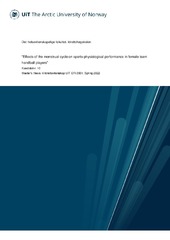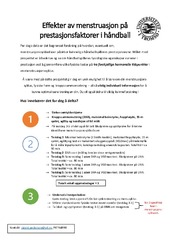| dc.description.abstract | <p>Objective: Team handball is a physically demanding sport. Research has not kept up with the increasing number of women participating in exercise and sports. The menstrual cycle (MC) is complex and should be included when conducting sport and exercise research on female athletes. Therefore, the main aim of this study was to investigate the potential effects of three different phases of the menstrual cycle phases (early follicular phase, ovulation, and mid luteal phase) on handball performance-related factors.
<p>Materials and methods: A total of 22 female handball players (age: 20 ± 3.6 years, body fat percentage: 27.7 ± 3.3) were recruited and completed the baseline testing, and 10 (age: 19.9 ± 2.9, body fat percentage: 27.6 ± 3.1) completed the MC- phase specific testing. The testing protocol included 1RM back squat in a Smith machine, maximal handgrip strength (in Ibf), maximal vertical jumping ability (squat jumps [SJ] and countermovement jump [CMJ], a modified agility T-test, and a maximal 15-m sprint. Subjects were both users of oral contraceptives (n = 2), hormonal implants (n = 3), mini pills (n = 1), hormonal IUD (n = 1) and naturally menstruating (n = 3). The MC phases were confirmed through venous serum blood samples, salivary testing, urinary ovulation test, and calendar-based counting. Data were analyzed using one-way repeated measures ANOVA.
<p>Results: There were no statistically significant changes for the three different phases of the MC, in terms of almost all the physical performance for the whole group: maximal handgrip strength (Ibf): EFP (109.9 ± 11.2), the OV (109.2 ± 11.7) and MLP (108.2 ± 11.6) for the left hand, and for the right hand for EFP (118.4 ± 11.1), for OV (119.2 ± 9.1) and for MLP (119.2 ± 9.1). Maximal CMJ (cm): EFP (26.0 ± 4.4), for OV (24.9 ± 3.5) and for MLP (25.8 ± 3.0). Repeated CMJ (average height of five jumps [cm]): EFP (23.5 ± 3.0), OV (23.2 ± 2.5) and for MLP (23.4 ± 3.4). Maximal SJ (cm): EFP (24.5 ± 3.8), the OV (23.6 ± 2.5) and for the MLP (24.3 ± 3.5). 15-m sprint (s): EFP (2.70 ± 0.15), the OV (2.71 ± 0.15) and for the MLP (2.68 ± 0.13). Agility T-test (s): EFP (6.63 ± 0.52), the OV (6.68 ± 0.46) and for the MLP (6.64 ± 0.49). A statistically significant change was observed in the 1RM back squat: EFP (99.9 ± 14.6), the OV (110.9 ± 13.7) and the MLP (113.9 ± 14.8).
<p>Conclusion: No statistically significant changes for maximal handgrip, CMJ repeated, CMJ max, SJ, agility T-test and 15-m sprint were found for the three different phases of the MC. A statistically significant change was found in the 1RM back squat test during one MC (EFP: 99.9 ± 14.6, OV: 110.9 ± 13.7, MLP: 113.9 ± 14.8), probably caused by a learning effect. | en_US |


 English
English norsk
norsk






